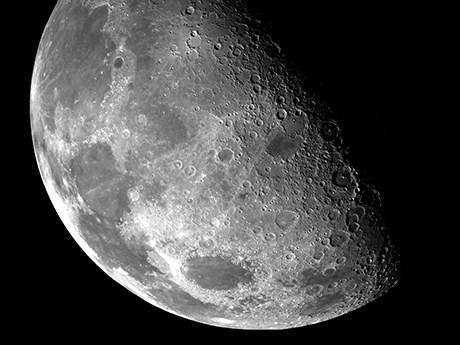Picture this. Somewhere in near-Earth orbit, a network of filling stations with attached Starbucks. Giant, space-based solar power stations beaming energy back to Earth. A mining operation and an industrial complex on the moon. Spaceships tearing back and forth, and exploration missions probing the far reaches of the solar system.
This is the vision that Jim Keravala, COO of the Shackleton Energy Company, shared with delegates at MassMin 2012 in Sudbury June 12th.
Keravala is no stranger to the space business. He served as director of a space company for seven years arranging launch programs and space access with Russian launch vehicles, and subsequently joined Surrey Satellite Technology as launch manager overseeing several successful orbital launches on Russian, European and U.S. launch vehicles. He is a graduate of the International Space University, a member of the International Institute of Space Law, a senior member of the American Institute of Aeronautics and Astronautics and a fellow of the British Interplanetary Society.
The major impediment to space exploration, explained Keravala, is the Earth’s deep gravity well and the high cost of transporting supplies, including propellant, to lower Earth orbit and beyond.
However, “the discovery of water on the moon has changed everything about how we think about space,” he told MassMin delegates in a plenary presentation. “Until now, we had to take all of our equipment and supplies up from the surface of the Earth to lower orbit and beyond.”
Now, with water on the moon to provide life support, power and propellant for transportation, we can have way stations with depots that will allow us to create a supply chain in space.
Politicized, government-driven space exploration hasn’t worked, complained Keravala. Budgets have been limited, and both direction and leadership have been lacking.
“If the mining industry worked on this model, we’d never get anything done,” he said.
Shackleton Energy “is privately financed, so we will not be relying on any government funding,” he noted.
“We start off with a core of firm leadership, we have clearly identified our customers’ needs and determined the technology required to get the job done. We’ve looked at the environment, the capital requirements and built a business model that generates revenues from a very early stage.
“Mining water from the polar ice on the moon and bringing it back to lower Earth orbit allows us to start a business that will yield a multi-billion dollar revenue stream in the first few decades.”
A growing population and finite resources on Earth are the ultimate drivers for Shackleton Energy’s ambitious plans.
“There are now seven billion people on Earth,” said Keravala. “By mid-century, we’ll be approaching 10 billion. That population growth will place an energy and consumables burden on the planet’s resources – not only because of the additional three billion people, but also because of the additional three billion people who want an increase in their standard of living.
“The energy sources that we have today in terms of petrochemicals are approaching a peak and will cost more to exploit. Currently, we’re using about 16 terawatts of power on a planetary scale, but that will almost double. If we stack up all of the energy sources that we have, including renewables, it still doesn’t add up to the 30 terawatts of power that we will require by mid-century.”
The answer is space-based solar power, said Keravala. Unfortunately, “launching an incredible amount of hardware from the Earth’s surface up to space to create fields of solar farms isn’t economically viable.”
Building the infrastructure on the moon would solve the problem, but would require what Keravala calls “an enabling platform” that could generate revenue in the near term through propellant sales to fund a growing moon-based industrial complex.
The Shackleton team is steeped in exploration and expeditionary experience, said Keravala. “We’ve gone to some of the world’s deepest caves for expeditions of 30, 40 and 50 people lasting months. We’ve established long duration stays under extreme conditions, cut off from resources and the outside world. We have developed and built our own life support systems for working in these environments.”
They have also undertaken missions to Antarctica. “We established base camps in some of the most remote regions and established operations to undertake scientific and exploratory work. We developed our own fully autonomous underwater robotic systems and introduced them to sub-glacial lakes. This is all capability that our team has already undertaken in terms of baseline design.”
Shackleton is working with Sudbury-based Penguin Automated Systems for the telerobotic technology it will need and has had discussions with Sudbury’s Northern Centre for Advanced Technology to tap its expertise developing coring drills under contract to NASA and the Canadian Space Agency.
By mid-2019, Shackleton Energy plans to launch two missions to the North and South Poles of the moon. Remote control rovers will do core drilling and sampling of the ice to quantify the available resource.
“It’s a very aggressive schedule, but we believe this will set up an economy that will open up the inner solar system and serve as a foothold to the stars.”




